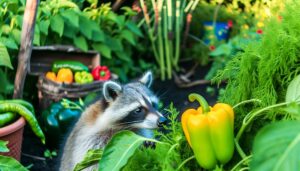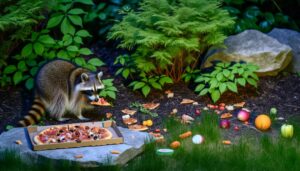How Do Raccoons Eat Your Cat’s Wet Food?
Yes, raccoons do eat wet cat food. As opportunistic feeders, raccoons are attracted to the strong scent and palatable taste of wet cat food, which aligns with their dietary preferences.
The high protein and fat content in wet cat food provides essential nutrients that support their health and energy levels. Their acute olfactory senses and nocturnal foraging habits make it easier for them to locate such food sources.
However, the consumption of wet cat food by raccoons can lead to potential health risks and may disrupt local ecosystems. Further insights into this behavior can offer more nuanced prevention strategies.
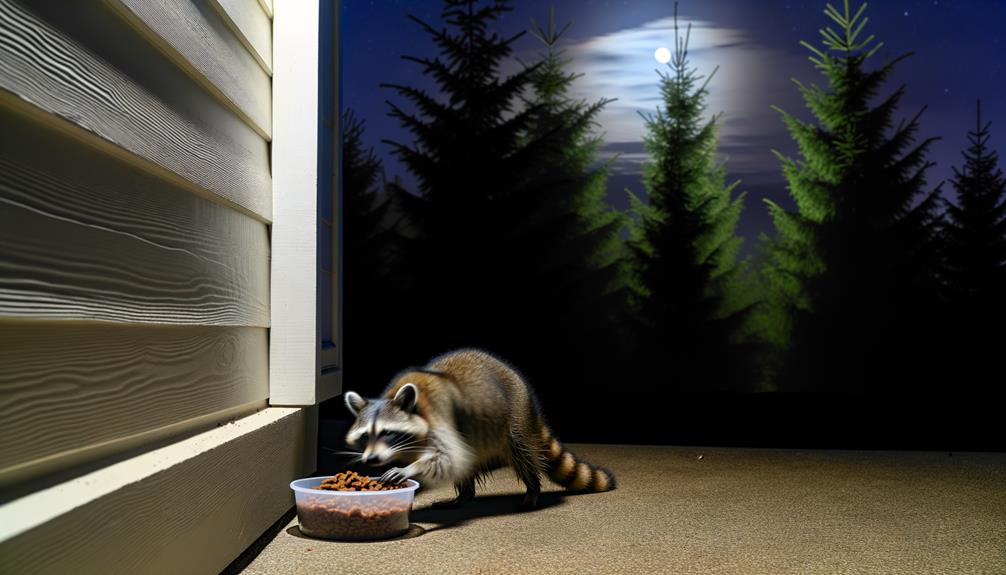
Key Takeaways
- Raccoons are attracted to wet cat food due to its strong scent and palatable taste.
- Wet cat food aligns with raccoons' dietary preferences for high protein and fat content.
- Raccoons' highly developed olfactory system helps them detect the aroma of wet cat food from a distance.
- Wet cat food's texture and smell mimic natural prey, making it appealing to raccoons.
- Nocturnal feeding habits of raccoons make them likely to forage for easily accessible wet cat food at night.
Raccoons' Dietary Preferences
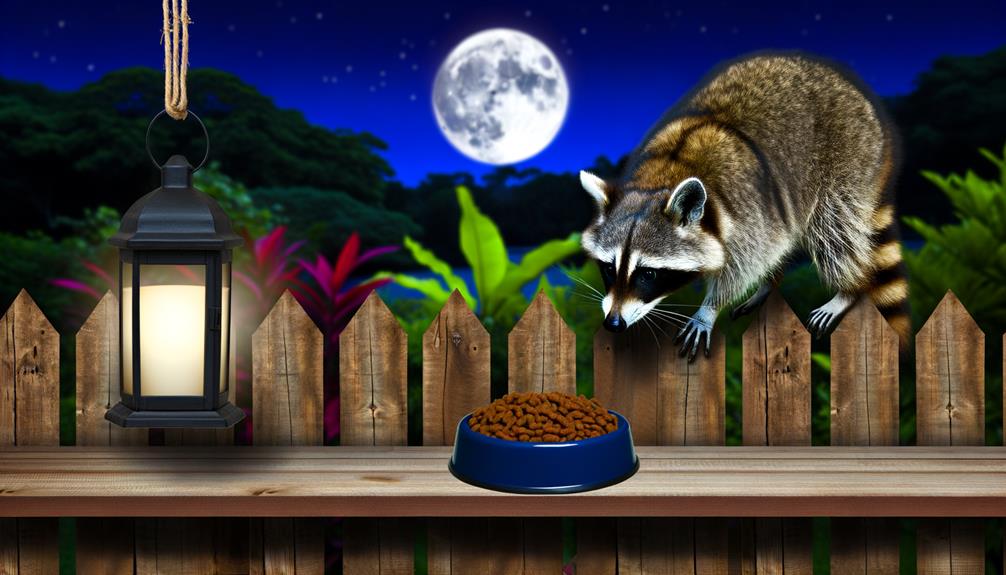
Raccoons (Procyon lotor) exhibit omnivorous dietary preferences, consuming a diverse array of food sources that include fruits, insects, small mammals, and human-provided scraps. These adaptable mammals demonstrate significant dietary flexibility, which is a critical factor in their survival across various habitats.
Their foraging behavior often involves opportunistic feeding, exploiting available resources in urban, suburban, and rural environments. Seasonal variations influence their diet; for instance, in warmer months, raccoons consume more fruits and insects, while in colder seasons, they shift towards nuts and small vertebrates.
This dietary adaptability not only supports their nutritional requirements but also plays a pivotal role in their ability to thrive in anthropogenically-altered landscapes, where natural food sources may be scarce.
Attracted to Wet Cat Food
Raccoons are particularly attracted to wet cat food due to its strong scent and palatable taste, which align with their omnivorous dietary preferences.
The high protein and fat content in wet cat food mimic the nutritional profile raccoons seek in natural food sources.
Additionally, common feeding spots such as urban areas and residential backyards often provide easy access to pet food left outdoors, further increasing the likelihood of raccoon encounters.
Scent and Taste Appeal
The strong, enticing aroma and rich flavor profile of wet cat food play a significant role in attracting raccoons to this type of nourishment.
Raccoons possess a highly developed olfactory system, allowing them to detect food sources from considerable distances. Wet cat food, with its robust scent and high protein content, mimics the nutritional profiles of their natural prey, making it particularly appealing.
Additionally, raccoons' taste receptors are adapted to detect amino acids and fats, which are abundant in wet cat food formulations. This sensory combination not only draws raccoons but also encourages repeated feeding behavior.
Scientific studies confirm that such sensory cues are critical in foraging decisions, underscoring the role of scent and taste in dietary preferences among raccoons.
Common Feeding Spots
Given their keen senses and attraction to the potent aroma of wet cat food, these nocturnal foragers frequently seek out feeding spots in urban and suburban environments where such food is readily accessible. Common locations include backyards, garages, and near pet feeding stations. Such areas provide a consistent food source, making them ideal for raccoons. The following table summarizes typical feeding spots and their characteristics:
| Location | Characteristics |
|---|---|
| Backyards | Easy access, often unmonitored |
| Garages | Sheltered, potential for food storage |
| Pet Feeding Areas | Regular food availability, low disturbance |
These settings offer both convenience and nutritional benefits, thereby attracting raccoons. Understanding these patterns can help manage unintended raccoon invasions and protect pet food sources.
Nutritional Value for Raccoons
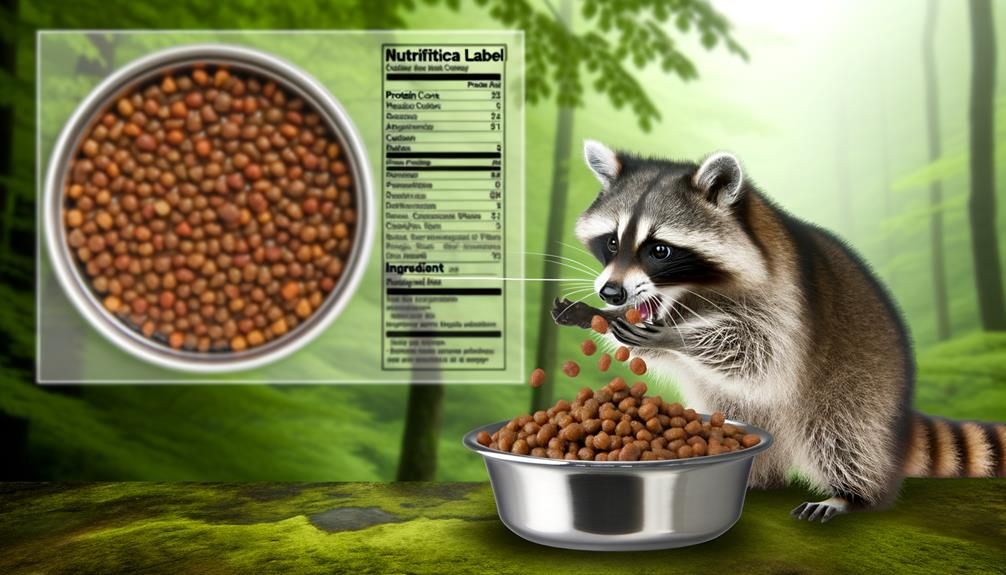
Wet cat food provides raccoons with essential nutrients, such as proteins and fats, that are vital for their overall health and energy levels.
The high protein content supports muscle development and repair, while fats offer a dense energy source necessary for their active lifestyle.
However, the imbalanced nutritional profile of wet cat food may lead to health issues if it becomes a significant part of their diet.
Essential Nutrients Content
Understanding the necessary nutrients in wet cat food is essential for evaluating its nutritional value for raccoons. Wet cat food typically contains a balanced mixture of macronutrients, including proteins, fats, and carbohydrates, alongside important micronutrients such as vitamins and minerals.
Key vitamins include A, D, E, and B-complex, which support various physiological functions. Minerals like calcium, phosphorus, and magnesium are vital for bone health and metabolic processes. Taurine, an amino acid prevalent in wet cat food, is crucial for cardiovascular and ocular health.
While these nutrients are formulated to meet feline dietary needs, they can also offer significant nutritional benefits to raccoons, aiding in growth, immune function, and overall health. However, specific requirements for raccoons may differ from those of cats.
Protein and Fat Benefits
The high protein and fat content in wet cat food can be particularly advantageous for raccoons, as these macronutrients play a fundamental role in their energy metabolism, muscle development, and overall health.
Proteins provide essential amino acids necessary for tissue repair and growth, essential for raccoons' active lifestyles. Fats serve as a dense energy source, aiding in the maintenance of body temperature and energy reserves, especially vital during colder months.
Additionally, fats facilitate the absorption of fat-soluble vitamins, enhancing raccoons' nutritional intake. Wet cat food often contains higher moisture content, which can aid in hydration.
Therefore, the nutritional profile of wet cat food aligns well with raccoons' dietary needs, supporting their physiological functions and overall well-being.
Impact on Health
Evaluating the nutritional value of wet cat food reveals its potential impact on raccoon health, particularly concerning macronutrient balance and hydration. Wet cat food generally contains high levels of protein and fat, which are essential for raccoons' energy needs and growth. However, the formulation is tailored to feline dietary requirements, which may not align perfectly with raccoon physiology.
Key nutritional aspects include:
- Protein Content: Essential for tissue repair and muscle growth but may be excessive for raccoons.
- Fat Levels: Provides necessary energy but could lead to obesity if consumed excessively.
- Moisture Content: Aids in hydration but may alter natural foraging behaviors.
Understanding these factors is vital for evaluating whether wet cat food can be a suitable supplementary food source for raccoons.
Smell and Texture Appeal
Raccoons are highly attracted to the strong smell and moist texture of wet cat food, which mimics the sensory cues of their natural prey. The olfactory sensitivity of raccoons is well-developed, allowing them to detect food sources with potent odors from considerable distances.
Wet cat food, rich in proteins and fats, emits a robust aroma that is particularly compelling to these omnivorous mammals. Additionally, the soft, pliable texture of wet cat food closely resembles the flesh of small animals and insects, which constitute a notably substantial portion of a raccoon's diet.
This combination of olfactory and textural cues greatly enhances the appeal, making wet cat food an irresistible option for raccoons seeking easy, nutritious sustenance.
Nocturnal Feeding Habits
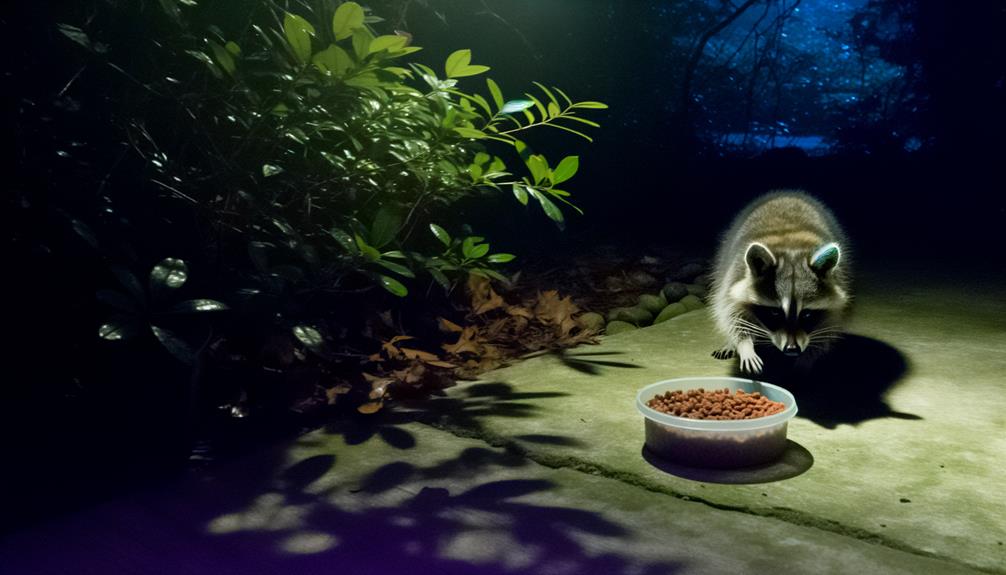
Exhibiting primarily nocturnal behavior, raccoons engage in foraging activities under the cover of darkness, leveraging their keen night vision and heightened sense of smell to locate food sources, including wet cat food, with remarkable efficiency.
This nocturnal activity pattern confers several advantages, including reduced competition with diurnal species and decreased risk of predation. Raccoons' adeptness at night-time foraging is facilitated by several physiological traits:
- Superior night vision: Enhanced by a reflective layer behind the retina, enabling better detection of low-light food sources.
- Acute olfactory senses: Allowing precise identification of food from considerable distances.
- Dexterous forepaws: Providing the ability to manipulate and access diverse food items efficiently.
These adaptations collectively underscore their proficiency in nocturnal foraging.
Risks of Raccoons Eating Cat Food
The consumption of wet cat food by raccoons presents several risks, including adverse health effects due to improper nutrition and the potential for disease transmission between raccoons and domestic animals.
Additionally, leaving cat food outdoors may attract other unwanted wildlife, thereby disrupting local ecosystems.
Understanding these risks is essential for mitigating negative consequences for both raccoons and the surrounding environment.
Health Concerns for Raccoons
Ingesting wet cat food poses several significant health risks to raccoons, including nutritional imbalances and the potential for exposure to harmful pathogens. Wet cat food is formulated specifically for feline dietary needs, which differ considerably from those of raccoons. Consequently, raccoons consuming such food may suffer from a lack of essential nutrients or an excess of certain ingredients.
Moreover, the consumption of wet cat food can expose raccoons to bacterial and viral contaminants, leading to infections and diseases. Additionally, wet cat food can spoil quickly, further increasing the risk of foodborne illnesses.
- Nutritional Mismatches: Cat food lacks the balanced nutrients raccoons require.
- Pathogen Exposure: Increased risk of bacterial and viral infections.
- Spoilage: Quick spoilage heightens the risk of foodborne illnesses.
Attracting Unwanted Wildlife
Leaving wet cat food outdoors can inadvertently attract unwanted wildlife, including raccoons and other opportunistic feeders. This attraction poses several risks, such as property damage, increased competition for food resources, and potential conflicts with domestic pets. The following table outlines some common wildlife species often drawn to wet cat food, highlighting the potential implications:
| Wildlife Species | Attracted By | Potential Risks |
|---|---|---|
| Raccoons | Wet cat food smell | Property damage, scavenging behavior |
| Stray Cats | Food availability | Increased aggression, disease spread |
| Skunks | Easy food source | Odor issues, garden destruction |
| Opossums | Accessible food | Nesting in attics/garages |
| Birds | Food remnants | Droppings, noise disturbance |
Understanding these risks is essential for pet owners who aim to minimize wildlife encounters around their homes.
Potential Disease Transmission
Raccoons consuming wet cat food can serve as a vector for several zoonotic diseases, posing significant health risks to both humans and domestic pets. The transmission of pathogens such as leptospirosis, raccoon roundworm (Baylisascaris procyonis), and rabies is a primary concern.
- Leptospirosis: A bacterial disease that can cause severe kidney damage, liver failure, and respiratory issues in both animals and humans.
- Raccoon Roundworm: This parasitic infection can lead to neurological damage, blindness, and even death if ingested.
- Rabies: A viral disease that is almost always fatal once symptoms appear, affecting the central nervous system.
Preventative measures, including securing food sources and maintaining hygiene, are critical to mitigate these risks.
Impact on Local Wildlife
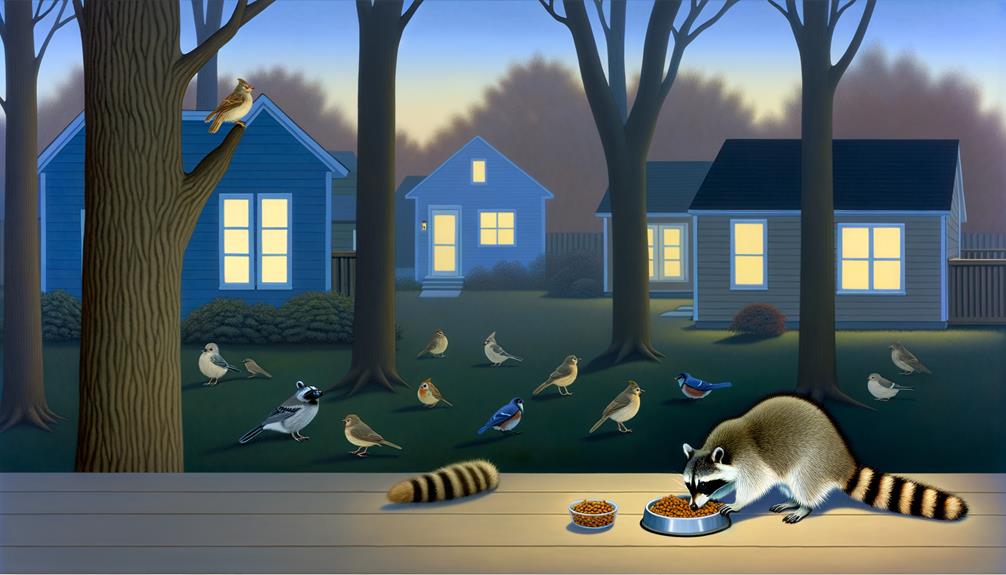
The introduction of wet cat food into suburban environments can greatly alter the feeding patterns and behavior of local wildlife species. Opportunistic feeders such as raccoons readily consume easily accessible food sources, leading to increased reliance on anthropogenic food items. This shift can result in altered foraging behaviors and potential imbalances in local ecosystems.
Besides, species that typically have minimal interaction with human-provided food may be drawn into human-populated areas, increasing the likelihood of human-wildlife conflicts. Additionally, the presence of wet cat food can attract non-native species, which may outcompete indigenous fauna for resources.
Such changes can have cascading effects, potentially leading to decreased biodiversity and disrupted ecological networks within these suburban landscapes.
Signs of Raccoon Presence
As opportunistic feeders increasingly rely on anthropogenic food sources, several indicators can reveal the presence of raccoons in suburban environments. Detailed examination of these signs can aid in the identification of raccoon activity, thereby facilitating appropriate responses. Key indicators include:
- Tracks: Raccoon footprints are distinct, featuring five toes on both front and hind feet, often resembling small human handprints.
- Scat: Raccoon feces are typically tubular and segmented, often containing visible remnants of their varied diet, such as fruit seeds or insect parts.
- Disturbed Areas: Raccoons are known to rummage through garbage, overturn compost bins, and leave behind evidence of consumption, such as opened food containers and scattered refuse.
These indicators collectively provide a robust framework for identifying raccoon presence.
Preventing Raccoon Encounters
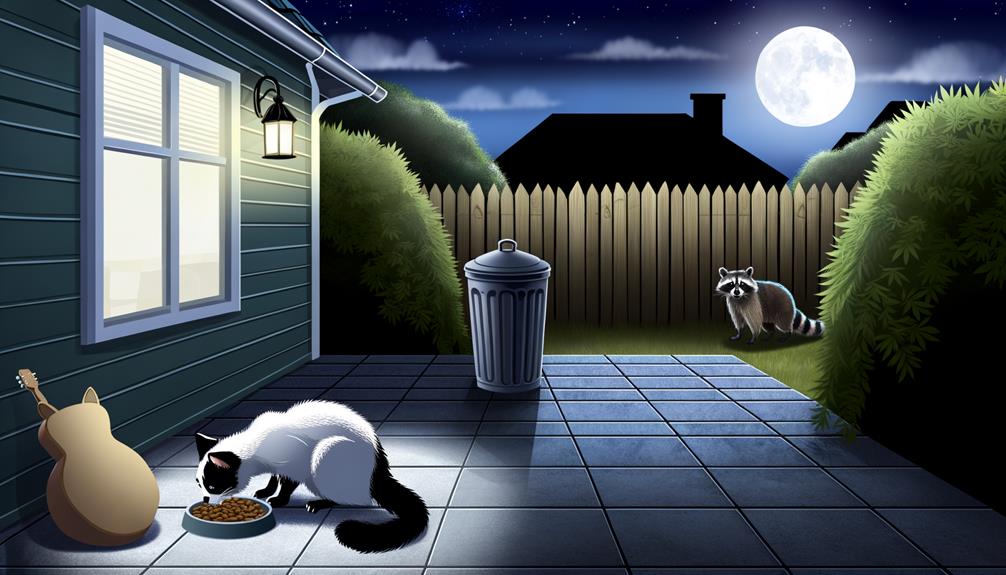
Implementing effective strategies to prevent raccoon encounters requires a multifaceted approach that addresses both environmental modifications and behavior adjustments.
First, securing garbage bins with tight-fitting lids reduces food attractants. Additionally, eliminating outdoor food sources, such as bird feeders, can deter raccoons. Habitat modification, such as trimming tree branches near structures, limits raccoon access to roofs and attics. Installing motion-activated lights or sprinklers can also serve as deterrents.
Behaviorally, avoiding leaving pet food outside overnight minimizes attraction. Ensuring that compost bins are raccoon-proof further diminishes potential food sources. Collectively, these strategies create an inhospitable environment for raccoons, thereby reducing the likelihood of encounters.
Employing these scientifically informed practices is essential for effective raccoon management in residential areas.
Securing Outdoor Pet Food
Addressing the issue of securing outdoor pet food is essential to minimizing raccoon attraction and ensuring effective wildlife management. Proper food storage techniques can markedly reduce the likelihood of raccoons accessing and consuming pet food, which is vital for maintaining ecological balance and preventing potential conflicts.
Important measures include:
- Utilizing airtight containers: This prevents the scent from escaping and attracting raccoons.
- Feeding pets indoors: This eliminates the possibility of raccoons encountering food in outdoor areas.
- Clearing food remnants: Ensuring that no leftover food is available post-feeding reduces attraction.
These strategies collectively contribute to an environment less inviting to raccoons, thereby aiding in the preservation of both pet health and local wildlife dynamics.
Raccoon-Proof Feeding Stations
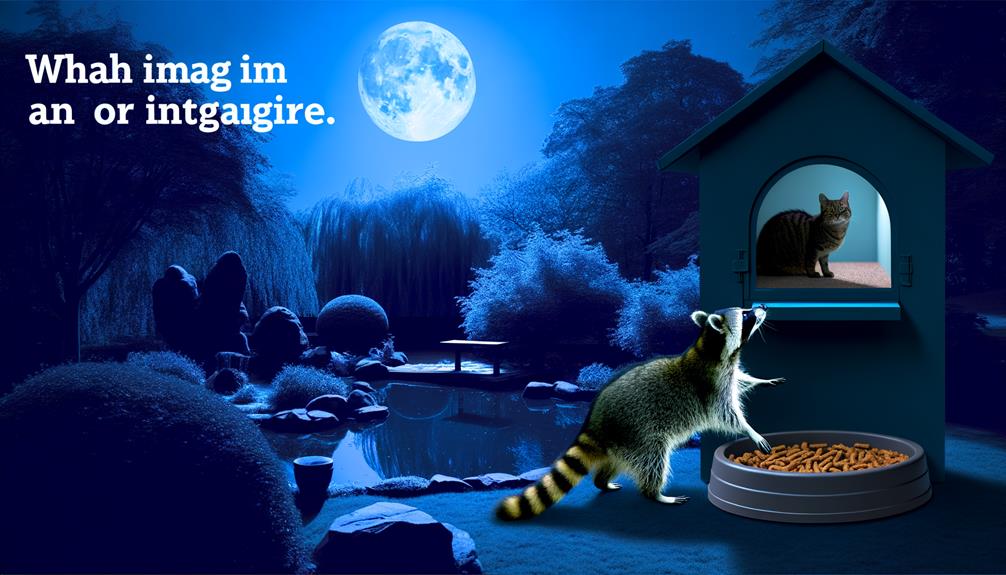
How can we engineer feeding stations that effectively deter raccoons while still providing access to domestic pets? The solution lies in designing structures that cater specifically to the physical and behavioral traits of raccoons and cats. Elevation, weight-sensitive platforms, and selective entry points are fundamental design elements. Elevated feeding stations exploit raccoons' limited climbing abilities compared to cats. Weight-sensitive platforms can be calibrated to allow lighter pets while excluding heavier raccoons.
| Design Element | Benefit | Consideration |
|---|---|---|
| Elevated Platforms | Limits raccoon access | Ensure steadiness for pets |
| Weight-Sensitive Entry | Excludes heavier raccoons | Calibration necessary |
| Selective Entry Points | Allows pet access via size | Appropriate for particular pets |
These elements, when integrated, provide a robust solution to raccoon-proof feeding stations.
Safe Alternatives for Feeding Pets
In addition to engineering raccoon-proof feeding stations, considering safe alternatives for feeding pets involves exploring various types of food and feeding methods that minimize attraction to raccoons.
Analyzing the nutritional components and olfactory signatures of pet food can lead to identifying options less appealing to raccoons. For instance, dry cat food generally emits a less potent scent compared to wet food, thereby reducing raccoon interest.
Additionally, specific feeding routines and locations can deter raccoons from accessing pet food.
- Dry Cat Food: Less aromatic and hence less attractive to raccoons.
- Scheduled Feeding Times: Remove food after pets have eaten to prevent raccoon scavenging.
- Indoor Feeding: Minimizes exposure to raccoons by keeping food inside the home.
These strategies collectively create a safer feeding environment for pets.
Conclusion
To sum up, the allure of wet cat food for raccoons is underscored by its appealing aroma and texture, coupled with its nutritional value. Raccoons' nocturnal habits increase the likelihood of such encounters, necessitating measures to safeguard outdoor pet food.
Implementing raccoon-proof feeding stations and securing food can mitigate these interactions. Offering safe alternatives for feeding pets outdoors can further reduce the attraction. Understanding raccoons' dietary inclinations aids in devising effective strategies to manage unintended wildlife feeding scenarios.

